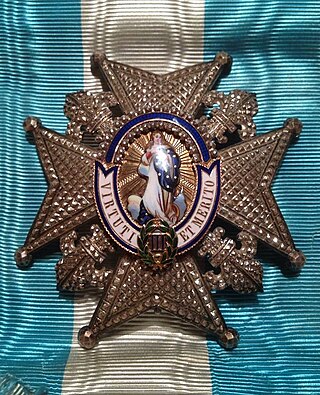
The Royal and Distinguished Spanish Order of Charles III, originally Royal and Much Distinguished Order of Charles III is a knighthood and one of the three preeminent orders of merit bestowed by the Kingdom of Spain, alongside the Order of Isabella the Catholic and the Order of Civil Merit. It was established by the King of Spain Charles III by means of the Royal Decree of 19 September 1771, with the motto Virtuti et mérito. It rewards political appointees, heads of State and high-ranking government officials for their actions in benefit to Spain and the Crown.
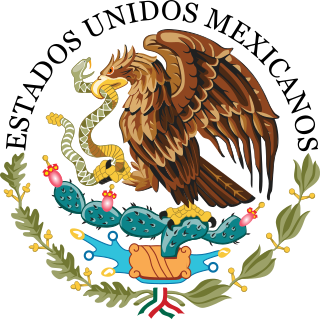
This is a list of military decorations awarded by the United Mexican States as part of the Mexican Honours System.

The Royal Order of Isabella the Catholic is a knighthood and one of the three preeminent orders of merit bestowed by the Kingdom of Spain, alongside the Order of Charles III and the Order of Civil Merit. It recognizes extraordinary services to the homeland or the promotion of international relations and cooperation with other nations, with a particular focus on the territories of the former Spanish Empire. By law, its Grand Master is the King of Spain, and its Grand Chancellor is the Minister of Foreign Affairs. The Order is open to both Spaniards and foreigners, particularly from the Spanish-speaking world.

The Royal and Military Order of Saint Ferdinand, is a Spanish military order of chivalry, the decoration of which, the Laureate Cross of Saint Ferdinand, is Spain's highest military decoration for gallantry. Membership of the order, which is sometimes abbreviated RMOSF, is awarded in recognition of action, either individual or collective, to protect the nation, its citizens, or the peace and security of the international community in the face of immediate risk to the bearer. Those eligible are current and former members of the Spanish Armed Forces.
Colombian military decorations date back as far as the founding of the country. An early decoration was the Cruz de Boyacá that was awarded to the generals who led their forces to victory in the Battle of Boyacá in 1819. This early decoration lives on today as an incarnation of the highest order presented by the Colombian state. There is one decoration higher, but it is only awarded for military conflicts in defence of Colombia. Other than military decorations, Colombia presents decorations on behalf of the National Government, decorations for the National Police, and decorations from the Congress of Colombia.
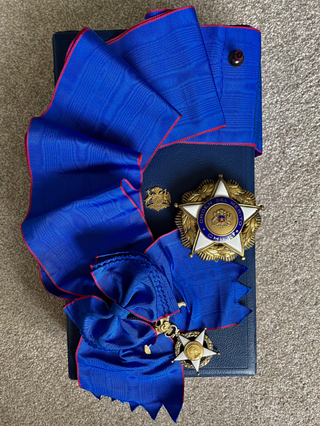
The Order of Merit is a Chilean order and was created in 1929. Succeeding the Medal of the Merit, which was created during the term of the President Germán Riesco through the Minister of War decree No. 1350 on 4 September 1906. This new national distinction was created to recognize the meritorious service provided by foreign military personnel to Chilean officials. The order is only awarded to foreigners.
This is a list of some of the modern orders, decorations and medals of Spain.
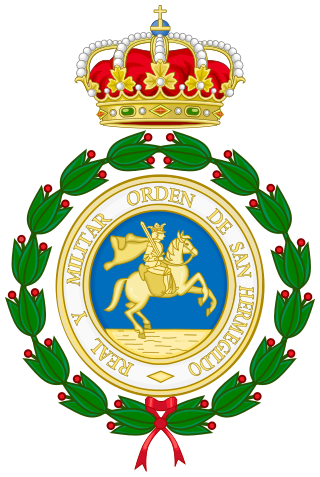
The Royal and Military Order of Saint Hermenegild is both a general military honor and a legion created by King Ferdinand VII of Spain on 28 November 1814.

The Royal Order of Civil Merit is a knighthood and one of the three preeminent orders of merit bestowed by the Kingdom of Spain, alongside the Order of Charles III and the Order of Isabella the Catholic. Each of the three orders aims to reward a distinct type of achievement without one outranking the others, although they are sometimes sorted by their year of inception. The Order of Charles III primarily honors heads of state and high-ranking government officials, while the Order of Isabella the Catholic primarily rewards services that strengthen diplomatic relations across the former Spanish Empire. In contrast, the Order of Civil Merit was created by King Alfonso XIII of Spain in 1926 to recognize "the civic virtues of the officials in the service of the State, as well as the extraordinary services of Spanish and foreign citizens for the good of the Nation." It was, therefore, founded as a modern order of merit, dedicated to acknowledging exceptional deeds for the benefit of civil society.
The Chilean honours system provides a means for the Government of Chile to reward gallantry, achievement, or service, by both Chileans and non-citizens. The honours system consists of three types of award: orders, decorations and medals. Membership of an Order is conferred to recognise merit in terms of achievement and service. Decorations are conferred to recognise specific deeds of gallantry, bravery, distinguished or meritorious service. Medals are conferred to recognise long and/or valuable service and/or good conduct. Awards to non-citizens are usually only made where the gallantry, achievement or service has advanced Chilean interests in some way. The honours conferred by the Chilean Republic can be divided into two groups: civil and military. Military honours are conferred by the different branches of the Armed Forces of Chile. Civil honours are conferred by the President of Chile or, in some instances, by the government minister relevant to the particular honour.
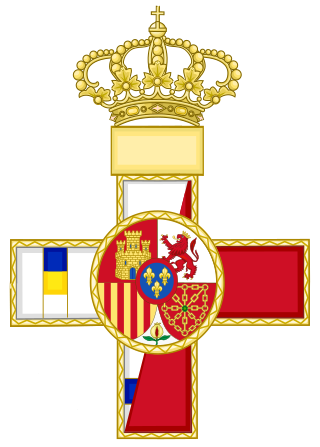
The Cross of Military Merit is Spain's military awards for gallantry or merit in war or peace. Awarded to members of the Spanish Armed Forces, Guardia Civil or civilians.

The Order of Constitutional Merit is a civil order of merit established by royal decree on 18 November 1988. The order is granted those who have carried out activities in service of the Spanish Constitution and its values and established principles. It may be granted to people and groups both public or private, Spanish or foreign. Recipients are treated as an Excellency.

The Order of Merit for Agriculture, Fisheries and Food is a Civil Order of Merit awarded by Spain. It is awarded to recognize people and organizations for outstanding performance in agriculture, fisheries, and food in all its manifestations. The order was established by Royal Decree 421/1987, on 27 February 1987.
The Medal for Service in War Overseas is a military decoration awarded by Colombia. Established in 1952, the medal was awarded in two classes to members of the Military Forces of Colombia who distinguished themselves in action during the Korean War.
The system of orders, decorations and medals of Uruguay consists of both military and civilian honours presented by the authorities of Uruguay with the purpose of recognising and rewarding actions or services considered praiseworthy.

The Cruz Fidélitas is a medal of the Spanish Armed Forces, primarily awarded to military chaplains. It is awarded by the military archbishopric to reward faithful service by chaplains, as well as services to the archbishopric by deserving civilians, institutions and other military personnel.

The Civil Order of Alfonso XII is a Spanish honorific decoration named for King Alfonso XII (1857–1885). It was established by Royal Decree on 23 May 1902 to reward achievements in education, science, culture, teaching and research.

Manuel Díez-Alegría Gutiérrez was a Spanish military officer who served as Chief of the Defence High Command (Alto Estado Mayor, AEM) between 1970 and 1974, i.e., chief of staff of the Spanish Armed Forces during the Francoist dictatorship.

The Commemorative Medal of the Fifth Centenary of the Proclamation of Saint Bárbara as Patron of the Artillery Weapon, commonly called the Medal of the V Centenary of Saint Barbara, is an official Spanish decoration created on December 4, 2021 to commemorate the five hundred years of patronage of Santa Barbara to the components of the Artillery Weapon of the Spanish Armed Forces. Created by the Military Archbishopric of Spain by virtue of the Agreements between the Spanish State and the Holy See of 1979, decreed by D. Carlos Jesús Montes Herreros, Military Ordinary of Spain, after the death of the Military Archbishop of Spain Juan del Río Martín in January of that same year, and the consecration of the newly appointed Military Archbishop-elect Juan Antonio Aznárez Cobo is still pending.

















